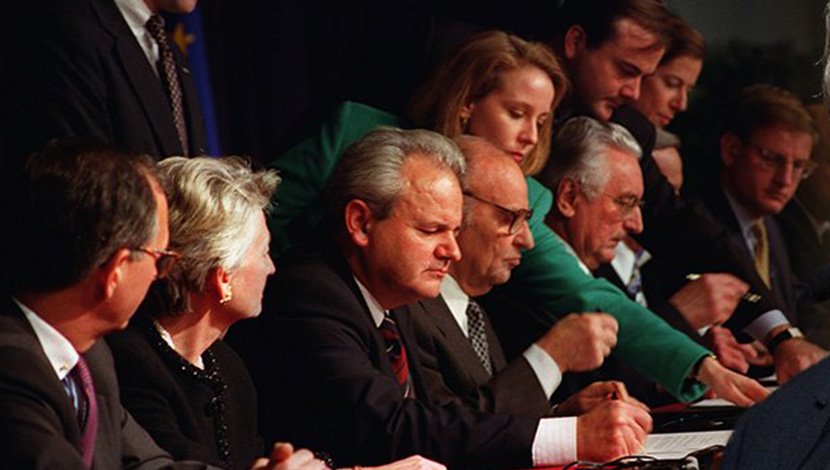30 years ago, Milosevic came to power: The day the people "gave him power to shape fate of Serbs"
Slobodan Milosevic was in power until October 5, 2000, when the victory of Vojislav Kostunica in the elections for the President of the Federal Republic of Yugoslavia was confirmed
30 years ago, at a session of the Serbian Assembly held on December 6, 1989, Slobodan Milosevic was declared president of the Presidency of Serbia. In addition to the election for the people's representatives, it was also a kind of presidential election because people went to a referendum to declare themselves on whether they accept the earlier decision of the deputies that Milosevic should be president of the Presidency of Serbia.
Under the the Constitution of the time, that office was equal to that of the president of state.
In those last one-party elections in Serbia, held on November 12, 1989, Slobodan Milosevic - who had three opponents running against him - Mihalj Kertes, Zoran Pjanic and Miroslav Djordjevic - manged a convincing victory in the race for the presidency of Serbia.
Milosevic triumphed at the time with the support he received from 4,452,312 citizens (80.36 percen). Afterwards, experts claim, it was clear who would rule the country in the coming years and "shape the fate of Serbs" despite the fact that the first multi-party elections were held in Serbia in late 1990.

Milosevic was officially declared President of the Presidency of the Federal Republic of Serbia at the Assembly session on December 6, 1989.
The first multi-party elections were held in 1990
The first multiparty elections for the National Assembly of Serbia after the Second World War were held on December 9 and 23, 1990, based on a decision of the National Assembly of Serbia to call elections and on the previously passed laws on election of deputies and election units. 5,030,440, or 71.49 percent of voters turned out at the polls out of the 7,036,303 registered voters.
The Socialist Party of Serbia won 194 seats, the Serbian Renewal Movement 19, the Democratic Alliance of Vojvodina Hungarians 8, candidates of citizens' groups 8, the Democratic Party 7. Slobodan Unkovic became the speaker of the first multi-party assembly, to be replaced by Aleksandar Bakocevic on June 6, while Dragutin Zelenovic became the head of government.
Simultaneously with the elections for deputies, the National Assembly of the Republic of Serbia also called elections for the President of the Republic. These elections were held on December 9, 1990 when Slobodan Milosevic was elected president. He was re-elected to the post two years later.
Speech at Gazimestan
Slobodan Milosevic's speech at Gazimestan during the 600th anniversary of the Battle of Kosovo on June 28, 1989 in Kosovo Polje is seen by some analysts as the official start of the Serbian nationalist campaign that was one of the elements of the Yugoslav crisis a few years after.
The anniversary was also marked by about two million people, some of whom came from the US, Australia and many countries in Europe.
The event was attended by the entire SFRY Presidency, headed by Janez Drnovsek, as well as by Milan Pancevski - then President of the Central Committee of the League of Communists of Yugoslavia, while the keynote speech was given by Slobodan Milosevic, then President of the Presidency of the Federal Republic of Serbia.
At the rally, Milosevic was definitely established as the Serb leader in the eyes of his opponents and the entire world.
In January 1990 at the 14th Congress of the League of Communists of Yugoslavia (SKJ), the Serbian delegation led by Slobodan Milosevic demanded the abolition of the 1974 Constitution, which gave equal powers to all republics. Milosevic demanded the introduction of a "one person, one vote" system, which would empower the Serbs, who were the majority population in Yugoslavia. Due to this proposal, the delegations of Slovenia and Croatia (led by Milan Kucan and Ivica Racan) left the congress. Subsequently, Milosevic realized that military presence had to be strengthened in Slovenia and Kosovo and Metohija.

He feared that separatists would receive a boost due to Slovenia's open support during the 14th Congress of the League of Communists.
The key tasks of the army were not to allow the breakup of the country nor anyone's violent or unconstitutional secession and civil war.
The war in Croatia began in April and May 1990, when Franjo Tudjman was elected president of the Socialist Republic of Croatia and immediately began a program aimed at Croatia's independence and leaving the SFRY (Social Federal Republic of Yugoslavia).
Then the disintegration of a great country began. There are also allegations and alleged evidence that Milosevic and Tudjman worked in concert, but we will never know because both actors in that story are dead - Milosevic passed away on March 11, 2006, in custody at The Hague tribunal, where he was tried for war crimes. while Tudjman died back in December 10, 1999.
There was no victor in this war, as the Serbs were expelled from their centuries-old homes, while the Croatian side suffered heavy losses because the war was waged in its territory. These wounds have not healed to this day, and for many people never will.

Already in 1992, the war spread to the territory of Bosnia and Herzegovina, where it lasted until 1995, when it ended with the signing of the Dayton Agreement.
Only four years later, a new war started for Serbia
In 1998, the Assembly repeatedly discussed what was then current security and socio-economic situation in Kosovo and Metohija and the issue of Albanian separatism. A referendum was also organized to let citizens of Serbia decide whether or not to accept participation of foreign representatives in solving the problems in Kosovo and Metohija. Nearly 95 percent of citizens out of 5,297,776 of those who voted in the referendum said "No."
At the beginning of February 1999, the National Assembly condemned in the strongest terms NATO's threats against Yugoslavia (FRY, at the time Serbia and Montenegro). The Assembly did the same on March 23 after the talks by the state delegation in Rambouillet and Paris. A day later, on March 24, 1999, NATO started carrying out its aggression against Yugoslavia.
Operation "Merciful Angel" was the final phase of the war in Kosovo and Metohija, lasting from March 24 until June 10, 1999. NATO's intervention was carried out without the approval of the UN Security Council, based on accusations that Serb security forces were conducting ethnic cleansing of Kosovo Albanians. The immediate cause for the operation were the events in Racak and the refusal of the Yugoslav delegation to sign the Rambouillet agreement.

NATO launched air strikes on military targets in the FRY at 8:45 pm on March 24, 1999, to later expand them to commercial and civilian facilities. The attacks, which lasted without interruption for 78 days, severely damaged infrastructure, business facilities, schools, health institutions, media organizations, cultural monuments, churches and monasteries. The estimated damage suffered by the FRY ranges from $30 billion to $100 billion.
The final death toll has not been officially announced, with Serbian estimates ranging from 1,200 to 2,500 killed and about 5,000 wounded. Several hundred thousand Albanians fled Kosovo during the war. The attacks were suspended on June 10, following the signing of the military-technical agreement to withdraw the Yugoslav army and police from Kosovo and Metohija.
On the same day, the UN Security Council adopted Resolution 1244, under which the FR Yugoslavia (later Serbia) retains sovereignty over Kosovo and Metohija, but the territory becomes an international protectorate under the authority of UNMIK and KFOR. With the army and police, more than 200,000 Kosovo and Metohija Serbs and other non-Albanians fled to Serbia.
On February 17, 2008, Kosovo Albanians unilaterally declared Kosovo's independence from Serbia, and it has remained a self-proclaimed state to this day.
Slobodan Milosevic was in power until October 5, 2000, when the victory of Vojislav Kostunica in the elections for the President of the Federal Republic of Yugoslavia was confirmed. He was taken to the Hague Tribunal on June 28, 2001, where he passed away five years later.
Video: What would have happened if Milosevic was overthrown on March 9?
(Telegraf.rs)
Telegraf.rs zadržava sva prava nad sadržajem. Za preuzimanje sadržaja pogledajte uputstva na stranici Uslovi korišćenja.




